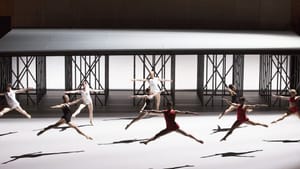Stay in the Loop
BSR publishes on a weekly schedule, with an email newsletter every Wednesday and Thursday morning. There’s no paywall, and subscribing is always free.
Let there be more light
Fringe 2015: 'Available Light' by Childs, Adams, Gehry

Considered from the standpoint of the early 21st century, Available Light is a remarkable phenomenon: a collaboration between three of the leading figures in contemporary American architecture, dance, and classical music. But at the time of the work’s 1983 premiere, Frank Gehry, Lucinda Childs, and John Adams had not yet broken through to artistic notoriety. The piece, performed by the Lucinda Childs Dance Company as part of this month’s Philadelphia Fringe Festival, now stands as a remarkable document of the United States avant-garde in the late 20th century.
Of the three artists involved, Childs is probably the least well-known today, although her work has been receiving more attention in recent years, including the wonderful website A Steady Pulse: Restaging Lucinda Childs, 1963-78, created by the Pew Center for Arts and Heritage. Active since the early 1960s, when she joined the pioneering Judson Dance Theater in New York, Childs is increasingly recognized as one of the foremost figures in contemporary dance.
Typical of all of her work, Childs’s choreography for Available Light is elegant, restrained, even neoclassical, a mood reinforced by the dancers’ togalike outfits in red, black, and white. As Susan Sontag explains in her essay “A Lexicon for Available Light” (which accompanied the program), for Childs, “beauty equals power, delicacy, decorum, unaffected intensity. What is ugly is timidity, anxiety, demagoguery, heaviness.”
Gently perturbed order
The most striking thing about the dance is its complete lack of solos, its rejection of individual virtuosity. In the entire performance, no dancer moves alone: Every set of motions is performed by at least two in perfect unison. The continuously shifting groupings create a sense of gently perturbed order often found in natural systems, such as the regular but aperiodic cresting of waves in the ocean.
The mirroring effect of the dancers’ movements is itself doubled by Gehry’s set, which features an elevated platform behind the main stage, accessible by stairs on either side. At any given moment, one to three dancers are on the upper stage, set off spatially from the other performers and yet maintaining the patterns of synchronization that connect all the dancers like an unseen filament.
Compared to the bracing rigor of Childs’s choreography, the music and stage set recede to the background — which does not necessarily mean they are less important. Adams’s electronic score, Light over Water, is a perfectly understated counterpart to the dance. Featuring drones, short repeated phrases, and a bright, glossy timbre, the music casts a subtle yet definite emotional and formal coloration over the entire performance.
Taken as a whole, Available Light does not hit you over the head emotionally, yet few would describe it as empty or unmoving. Ready-to-hand epithets such as “minimalist” or “abstract” seem insufficient, and one struggles to define the experience in terms of what it is, rather than what it’s not. Like much of the best experimental art, the expressive force of Available Light is, so to speak, negative: Rather than forcefully imposing itself, the work simply creates a space in which the audience is free to project its own meanings. In Sontag’s words, it is “an art of refusal,” but its beauty is no less real or powerful for that.
What, When, Where
Available Light, performed by the Lucinda Childs Dance Company. Music by John Adams; choreography by Lucinda Childs; stage design by Frank Gehry. September 10-12, 2015 at the Drexel Armory, 32nd and Cuthbert Streets, Philadelphia. Part of the Philadelphia Fringe Festival.
Sign up for our newsletter
All of the week's new articles, all in one place. Sign up for the free weekly BSR newsletters, and don't miss a conversation.